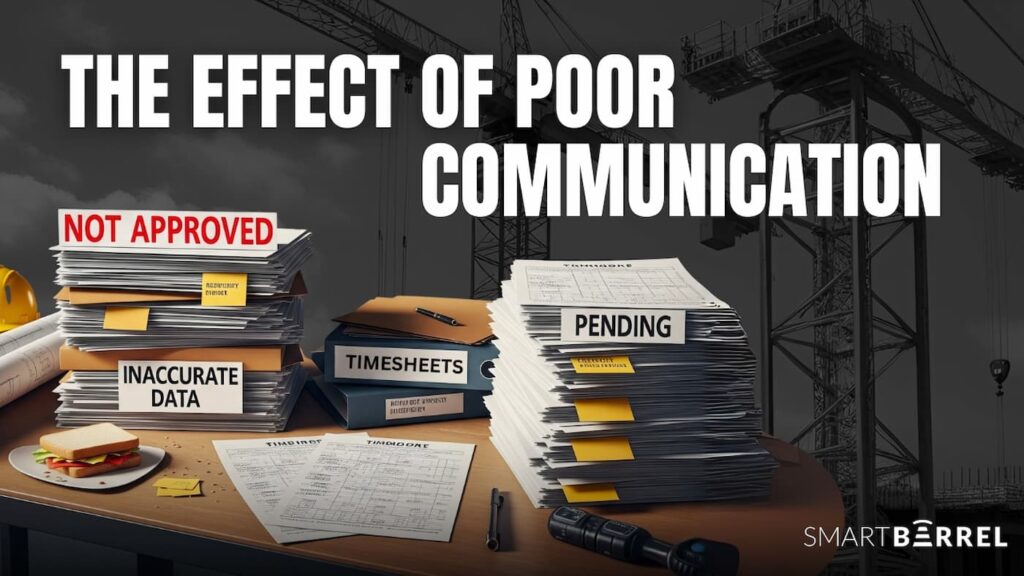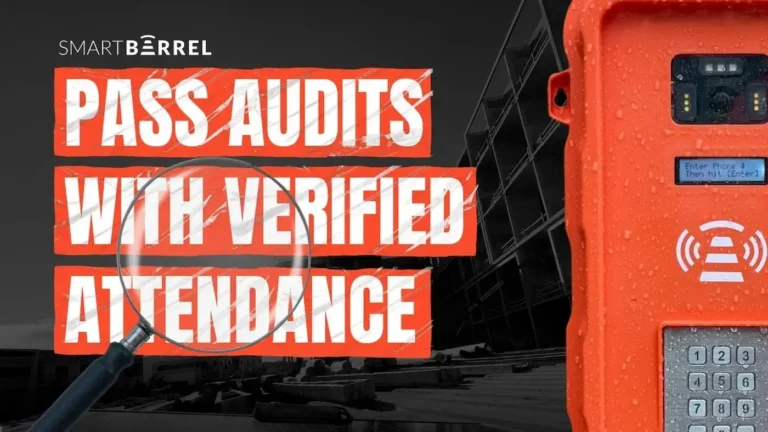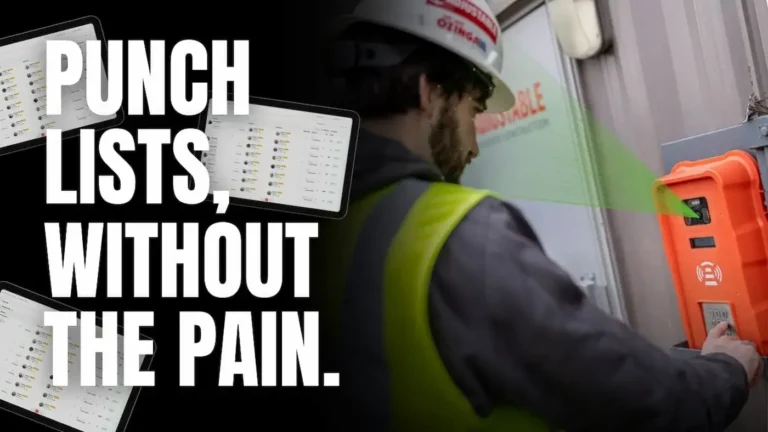When communication breaks down in the field, it shows up fast in delays, rework, and unexpected costs. According to the Construction Industry Institute, rework alone can cost between 2% and 20% of the total construction project value. This is often triggered by miscommunication, poor documentation, or unclear approvals.
Even a conservative 5% hit equals half a million dollars in lost labor, materials, and opportunity on a $10 million scope.
You feel it when concrete trucks wait because sleeves are off, when electricians pull nights to catch up, or when payroll totals suddenly look heavy. Those losses don’t always happen loudly; they build quietly when hours are logged manually, photos never get submitted, or notes stay buried in texts.
This guide shows exactly where those dollars slip away and how clear, verified data helps you win those hours back.
Why Construction Communication Makes or Breaks Profit
Communication holds people, plans, and materials together in the construction world. Even the most perfect schedule turns into chaos in its absence. There are three things that good communication can do:
- Keeps time tight: Crews understand what they are doing, where, and to what extent. All tasks fit into place.
- Controls cost: Accurate hours and right-first-time work maintain the labor cost curve below the target line. Clear production tracking keeps direct labor costs visible and precise.
- Builds trust: With the rapid flow of information, owners no longer hover, and inspectors can move confidently on the jobsite.
On the other hand, poor construction communication leaves cracks all over. Minor missteps turn into delays, confusion, and costly rework. Even the best crews waste time chasing answers when updates get lost in emails, texts, or radio static. Subs end up footing the bill for delays they didn’t cause, and can’t prevent without real-time info. Morale drops, and progress stalls under a pile of mixed messages.
Get Control of Your Time Tracking
Where Construction Communication Fails First
Spotting weak links early helps prevent communication issues from becoming costly.
Overloaded Channels, Cross-Talk, and Guesswork
Concrete, mechanical, and drywall crews often use the same radio. When the crane asks for a lift or safety warns of falling tools, normal updates get cut off. By lunch, many people work from memory. Layout marks fade, crews wait, and work slows down. Foremen must explain things again, slowing down work that was already behind. If the marks are wrong, you get reworked fast.
Foggy Chains of Approval
A field engineer draws a fix to keep things moving, but no one confirms whether it overrides the stamped plan. On fast-paced jobs, this is easy to miss. Crews keep building to stay on track. Two days later, QC marks it wrong, and the team has to tear it out. You lose time, waste material, and damage trust with the owner or your GC.
Daily Logs Trapped on Phones
Foremen take pictures and write headcounts, but forget to send them in. When the superintendent checks the log days later, it’s too late. Concrete has already set over a missing part. Now the crew has to stay late and fix it. Overtime eats the budget.
Verbal “Looks Good” Approvals
Someone says, “Looks good” while passing by, but nothing gets written down. Later, during the punch list, the trades argue over what was said. What seemed fine becomes a big issue. Without proof, it turns into a fight, not a fix.
Unverified Timesheets Inflate Costs
When hours are tracked manually, crews often estimate time at week’s end. Even ten extra minutes per person per day adds up — for a 30-person crew, that’s a full shift each month. These small overages inflate payroll, create disputes, and delay approvals. It’s a silent cost that hits every week.
The Real Costs of Poor Communication in Construction
Poor communication is a leading cause of one-third of all project failures. On the job site, that means rework, delays, and lost profit before you even see it coming.
Loss Category
Average Cost per Contract
Communication Failure
Get Control of Your Time Tracking
Why Verified Time Data Closes the Gaps
Verified hours end the guesswork. SmartBarrel verifies every punch with facial matching and enforces project-level geofencing if set, then sends the data straight to the dashboard in real time.
- Kills time padding: Face-match equals one person, one punch. No more inflated hours or buddy punches, and admins can control rounding rules to stay compliant.
- Pins labor to the right task: Back office teams assign cost codes to punches early, so every minute lands in the right bucket before noon, not on Friday.
- Builds an instant daily log: Hours, photos, and notes feed a single report, no manual copy, no mixed versions.
- Moves meetings forward fast: When hours are stamped and shared, meetings shift from blame to next steps.
Verified time is the backbone of effective communication in construction. It shifts every conversation from opinion to proof, giving project teams the clarity they need to act quickly, cut waste, and protect profit.
6 Strategies to Improve Construction Communication
Clear talk starts with a clear structure. The six moves below give every crew the information they need.
1. Choose a Trusted Hub for Field Data
Your team needs one place to capture and reference what really happened on site. For subs, that means a system like SmartBarrel, where photos, verified hours, and field notes come together automatically.
Side texts, scattered emails, and forgotten paper notes quietly drain profit. When your crew and back office share one dashboard, it’s easier to spot issues early, resolve them fast, and protect your bottom line.
Here’s how one source of truth strengthens site communication and transparency.
2. Lock Roles on Day One
Write a one-page construction communication plan that spells out who owns what:
- The PM signs off on scope changes and cost impacts.
- The super captures progress, issues, and manpower counts.
- Foremen upload photos and field notes before leaving.
- Office staff review and export verified hours, assigning cost codes as needed.
Review the sheet during the kickoff meeting, post it in the trailer, and save it in the project dashboard. When gray areas pop up, the sheet ends the debate.
3. Run Daily Micro-Huddles
Hold a ten-minute stand-up at the start of the shift and a five-minute recap before tools hit the box. Cover:
- Critical tasks and their locations.
- Known hazards and required controls.
- Material drops or crane picks that affect the site.
Start on time, end on time. Crews learn to show up ready, and last-minute questions disappear.
4. Automate the Daily Log
SmartBarrel pulls weather, headcounts, and verified hours into the dashboard automatically. Foremen can snap photos and leave notes in the mobile app to document what happened on site — whether it’s progress, punch list items, or issues.
Admins can review, upload, or add supporting records in the dashboard to keep everything aligned for safety, billing, or project approvals. When field updates are submitted the same day, problems get fixed fast — not buried in rework next week.
5. Train for Simplicity and Speed
New hires can punch in on the tablet without training. Foremen keep quick reference guides handy for features like photo capture or log notes. A quarterly video refresher, sent by text, helps keep things running smoothly without slowing down the job.
When the system stays simple, workers use it without being told. That’s how construction communication stays sharp from day one to close-out.
How Technology Keeps the Jobsite Aligned
SmartBarrel turns raw field activity into clear, verified data. That single source of truth keeps everyone on the same page even when a project hits full speed.
Verified Punches Only
A foreman mounts the SmartBarrel TimeClock 4.0 at the gate on day one. Every worker clocks in with a quick selfie, typically taking just a few seconds. The system matches the face to the worker’s original photo and locks the punch to a project’s geo-fenced site boundary if set. No one clocks in from the parking lot. No one clocks in for a buddy. It prevents padded hours, something paper time tracking makes far too easy.
Live Labor Dashboard
The system pushes hours to a real-time dashboard, where project admins assign cost codes based on scope. With verified hours flowing into the dashboard throughout the day, PMs can catch labor overages early and shift manpower before issues escalate.
If it is, the PM shifts manpower that same afternoon instead of finding the bad news at month-end. Budget swings stay small because action is quick. This visibility helps improve communication between the field and the office.
Photo-Linked Field Notes
Foremen snap photos in the SmartBarrel app and attach notes as part of their daily reporting. Those timestamped images flow straight into the dashboard, where they appear alongside verified labor hours, giving office teams visual proof of what got done and when.
Instant Visibility Where It Counts
When geofencing is enabled, SmartBarrel only shows eligible projects within the allowed radius—so workers can’t punch in outside your defined site boundary. After verified hours land in the dashboard, cost-code trends and crew totals are visible in real time. That gives project teams the clarity to catch anomalies before they become expensive problems.
Seamless Time Transfer
At the end of the week, the office syncs verified hours directly into CMiC or Viewpoint Vista, or exports them for upload into systems like Sage or QuickBooks. There’s no double entry, no math slips, and no late checks.
Workers like the accuracy; accounting loves the saved hours. It’s one more way contractor communication is streamlined from field to finance.
Building a Culture of Accountability and Clarity
Accountability grows when everyone trusts the data and sees results.
- Share the numbers: Post a weekly dashboard in the trailer showing rework hours, overtime percentage, and on-time daily logs. Crews see progress in real time and take ownership when rework and overtime drop.
- Reward good habits: Call out the foreman who submits daily notes or flags issues the same day they surface, and hand over a small gift card. A $50 reward costs less than a single hour of rework.
- Lead by example: Superintendents punch into the SmartBarrel unit and add notes to the daily log just like everyone else. When leaders follow the process, crews know it matters. A strong communication chain supports that consistency.
- Review and adjust: Use one short monthly stand-up to scan KPIs. If rework or overtime spikes, tighten the workflow and document the change—no finger-pointing, just a better plan.
The Simple Construction Communication Plan That Works
- Define the chain. One page lists roles and contact points.
- Pick the hub. All digital info flows through a single platform.
- Set response times. RFIs are acknowledged in four hours, and change approvals in 24 hours.
- Automate logs. Let software build drafts; foremen add context.
- Audit weekly. Check rework, overtime, and log timing. Adjust fast.
Print the plan, distribute it, and review it at the start of each new project. This construction communication plan ensures clarity, speed, and accountability.
Long-Term Payoff: Lower Costs, Fewer Disputes, Happier Clients
Clear communication doesn’t just prevent mistakes in the moment; it reshapes how you bid, build, and deliver profit over time.
Rework Hits Twice
Tear-out is bad. Reinstall is worse. Both burn labor you have already budgeted elsewhere. One wrong bolt pattern in a beam seat can snowball into days of fixes across trades.
Overtime Premiums
When crews slip behind, the only lever left is time. Nights and weekends cost 150% to 200% of the standard rate. Money flows out fast, and fatigue sets in, risking safety.
Hidden Time Theft
Ten extra minutes per shift sounds small. Multiply it by 50 workers and 240 days, and you lose hundreds of paid hours. Without verified punches, padded time slips through, and it’s nearly impossible to dispute after payroll runs. Here’s how to eliminate hidden time theft with modern solutions.
Disputes and Legal Spend
Owners hold back pay apps when time or cost codes are murky. Lawyers step in. Even if you win, billable hours stack up. Cash flow slows, and opportunity costs rise.
Insurance Penalties
When near-miss reports don’t get logged or sent to safety, small risks turn into serious incidents. Just one recordable injury can spike your EMR and drive up insurance costs for years.
All of this stems from gaps in the construction process that compound over time.
Payoff
How Better Communication Delivers It
Get Control of Your Time Tracking
Conclusion and Next Steps
Poor construction communication is costly, but it’s not hard to fix. Start with a clear plan, back it up with verified data, and share progress openly. SmartBarrel verifies hours with facial verification and captures field notes in real time, giving your team the clarity to act fast and cut waste.
See how verified data changes the way you run your jobs. Book a SmartBarrel demo today.




